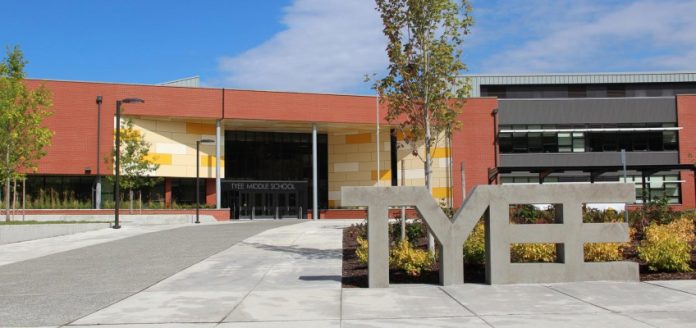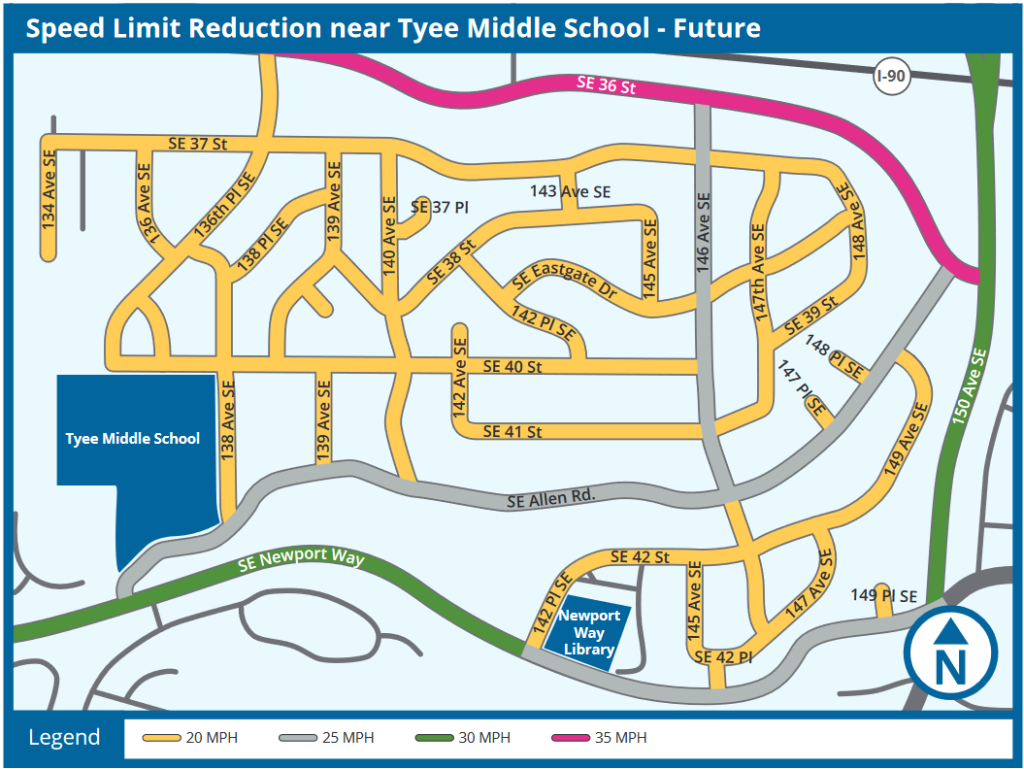
Among other actions taken at Monday’s meeting, Bellevue City Council voted to lower speed limits on some residential streets, discussed guidelines for awarding arts grants, and provided feedback on staff’s update to the City’s Parks and Open Spaces plan.
Speed limits on local roads in Eastgate lowered to 20 miles per hour, citywide action might follow
As part of Monday’s consent calendar, City Council unanimously voted to reduce speed limits from 25 to 20 miles per hour on local roads near Tyee Middle School. This Eastgate community became the third Bellevue neighborhood to have its speed limits reduced to 20 miles per hour, joining the Surrey Downs neighborhood and portions of Lake Hills along the East Bellevue Demonstration Greenway. Transportation staff’s report noted that speed limit reductions are both in line with best practices from the National Association of City Transportation Officials (NACTO) and have been well-received by Bellevue residents. Traffic studies show that the risk of death for pedestrians involved in auto collisions increases exponentially as vehicle speed increases. Lowering vehicle speeds by implementing reduced speed limits is therefore one way that city officials seek to reduce traffic-related deaths.

During his weekly report to City Council, City Manager Brad Miyake shared that transportation staff are looking at a citywide speed reduction approach for local roads as part of Bellevue’s Vision Zero Strategy. Councilmembers will have an opportunity to weigh in on the strategy, as well as other safe streets priorities, when transportation staff presents a Vision Zero update in April.
New guiding framework for public arts grants
Each year, Bellevue awards thousands of dollars to artists and artistic organizations through three different grant programs. Depending on the grant, funding can be used to help creative non-profits build staffing capacity, bring free performances and exhibitions to city residents, support special projects, and many other artistic ventures. Applications for City arts grants open to the public once per year and are reviewed by the City’s Arts Commission before being ultimately approved by City Council.
Because total grant requests often exceed the available funds, the Arts Commission uses a prioritization framework to help decide which organizations and artists should receive funds. However, staff cited conversations with former grantees and the City’s Diversity, Equity, and Inclusion department as instigators for a review of this framework. In their update, staff will be looking to incorporate prioritization guidelines that increase equity, reduce barriers for smaller artistic organizations, and make sure that the current grant structure is commensurate with the needs of the artistic community in Bellevue.
To this last goal, both staff and councilmembers noted that the available funds are not keeping up with the demand. In response to a question from Mayor Lynne Robinson, staff shared that, on a per-capita basis, arts grant funding in Bellevue is nearly six times less than that of Seattle and four times less than that of Issaquah. With municipal budget discussions coming later this year, City Council will have the opportunity to decide how much is dedicated to this program.
A glimpse at the new Parks and Open Spaces plan
Similar to the City’s Comprehensive Plan, Bellevue maintains a Parks and Open Spaces plan that is updated every few years. This guiding document outlines priorities for new facilities, identifies current gaps in the parks system, and provides a long-term vision for green spaces in the city. After a lengthy community outreach process late last year, city staff are currently drafting the first update to the plan since 2016. Key additions to this year’s iteration included, among other things:
- Prioritizing development of a park in the Eastgate neighborhood, which lacks parks facilities compared to other Bellevue neighborhoods;
- Recognizing the potential for new historical and cultural resources along Eastrail; and
- Supporting the development of facilities for sports increasing in popularity, like cricket and pickleball.
As I’ve mentioned on Twitter, planning documents and guidelines like these can seem generic and hard to follow, but their importance can’t be understated. The priorities defined in these planning documents form the basis for which decisions get made down the line — in other words, these plans have a large impact on what park projects get to be funded, built, and ultimately enjoyed by the community.
In their presentation to City Council on Monday evening, staff provided an initial overview of the draft plan and sought preliminary feedback from councilmembers, which was mostly supportive. Councilmembers across the ideological spectrum underscored the importance of parks facilities in creating spaces for cross-cultural engagement, but concerns were raised by Councilmember Conrad Lee on how staff came to their decisions on which facilities to prioritize. His colleagues agreed that larger discussions needed to be had on how the City conducts public engagement, but advised that this would be a good topic for discussion at this week’s City Council retreat.
This annual retreat, scheduled this week from Thursday to Saturday, will be an opportunity for councilmembers to outline their general vision and priorities for Bellevue. In a future article, I’ll explain what this retreat means for City priorities, how it affects staff’s actions, and what outcomes councilmembers seek from their three days together.
Chris Randels is the founder and director of Complete Streets Bellevue, an advocacy organization looking to make it easier for people to get around Bellevue without a car. Chris lived in the Lake Hills neighborhood for nearly a decade and cares about reducing emissions and improving safety in the Eastside's largest city.

